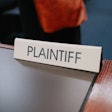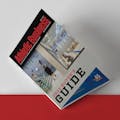
As pointed out frequently in this space, one of the most important legal duties of sports and recreation facilities is to provide a safe environment for activities to be performed. To do this, facility owners and operators have a legal duty to regularly inspect facilities for dangers, both seen and unseen.
Under the law, clients who visit a sports or recreation property are considered “invitees,” and as such are owed the highest level of care. Specifically, sports and recreation entities have a duty to inspect their facilities and activities and inform clients of those dangers that are known or should have been discovered through reasonable inspections. Specifically, sports and recreation administrators need to inspect their facilities daily and correct any defects or dangerous conditions.
The duty to inspect and correct any defects is especially important when the activities on the property are performed using equipment that was purchased by the facility owner second-hand and installed without the aid of the manufacturer’s instructions. An example of what happens when facilities fail to correct dangerous conditions created by the improper installation of previously owned equipment is Beyer v. Brownstone Exploration & Discovery Park, LLC, NO: CV-17-6017720-S, 2024 Conn. Super. LEXIS 2011.
Second-hand lily pads
While visiting the Brownstone Exploration & Discovery Park, which does business as the Brownstone Adventure Sports Park in Portland, Conn., Charles Beyer decided to use the “lily pads” water activity, which featured five floating lily pads — each circular and approximately 5 feet in diameter. The goal of the activity is to jump from one lily pad to another without falling into the water. Each of the lily pads had a separate cable attached to its underside to anchor the pad to the pool bottom.
When the lily pads were purchased by Brownstone owner Sean Hayes for $300 at a former Waterbury waterpark’s bankruptcy auction, they came with neither the manufacturer’s installation instructions, nor the manufacturer’s safety instructions. In addition, Hayes did not have the lily pads installed by professionals but instead directed his employees to install them, even though he knew his employees were not qualified to do so safely.
Within weeks of Brownstone’s installation of the lily pads, and prior to Beyer’s visit, a visitor to the park cut their foot on the exposed c-clamps and heavy metal anchor chains severely enough to require first aid to treat the bleeding. As a result of this injury, Brownstone Park had knowledge of the danger that the submerged anchoring chains and c-clamps presented to park guests. Despite knowing the potential danger that the lily pads posed to park visitors, Brownstone disregarded the risk and not only continued to allow guests to engage in the lily pad activity, but he also made no effort to remove the lily pads from the waterpark or to warn subsequent park guests about their hidden danger.
While jumping from pad to pad, Beyer slid off the fifth pad and fell into the water feet first. As in the previous incident, Beyer’s left ankle hit something sharp that was part of the underwater cable mechanism used to anchor the pad, resulting in a deep cut on his left foot and ankle that caused nerve damage, extensive scarring, swelling and infection.
As a result of his injury, Beyer sued Brownstone for negligence. In support of his claim that Brownstone was negligent, Beyer argued that the waterpark knew or had reason to know of the unsafe condition on this lily pad activity, and that it failed to take proper steps to repair and/or remedy the unsafe condition.
Prior to the trial, it was discovered that the lily pads were made by a Colorado company, which stated that the c-clamps and heavy metal anchor chains connecting the pads to the pool floor were supposed to be covered with a plastic sheath. In the case of their second owner, Brownstone improperly and dangerously installed the pads.
Negligence, non-economic damages
Brownstone Park eventually conceded that it was negligent for Beyer’s injuries prior to the commencement of the trial, so the sole issue at trial was the question of “non-economic damages.” Beyer claimed non-economic damages for the nerve damage to his foot that caused pain and suffering and impacted his life activities
After all the evidence was presented, the jury rendered a verdict for Beyer in the amount of $9 million for non-economic damages: $3 million for past and $6 million for future non-economic damages.
On appeal, Brownstone argued that the court should set aside the jury’s verdict and order a new trial. In support of this argument, Brownstone argued that the verdict reached is so excessive that it demonstrates that there was no reasonable basis for the amount awarded. The defendant argued that the non-economic damages of $9 million was not based on the evidence at trial, because the evidence showed that the plaintiff missed no work, claimed no lost earning capacity, had no loss of life expectancy, had no permanency rating and continued to do everything he did before, including skiing in Colorado within months of the incident in Connecticut.
The defendant further pointed out that the plaintiff took minimal pain medications and had not explored other options to alleviate the pain he claimed. Quite simply, the defendant contended that Beyer’s claimed pain and suffering, even when seen in the light most favorable to the plaintiff, could not sustain a $9 million award.
The appeals court, however, declined to set aside the verdict because of Brownstone’s claim of excessiveness. In addressing the excessiveness of the award, the court held that the fact that the jury returned a verdict in excess of what the trial judge would have awarded does not alone establish that the verdict was excessive. The court’s proper function, therefore, is to determine whether the evidence, reviewed in a light most favorable to the prevailing party, reasonably supports the jury’s verdict.
Buy new, save later
In awarding $9 million in damages to Beyer, the jury sent a clear message to those who operate sports and recreation facilities.
First, sports and recreational facilities have a legal duty to provide their clients with a facility that is free of dangers, both known and unknown. If the landowner or facility operator has actual notice of a dangerous condition, and has sufficient time to correct the condition, they are required to either correct it or prevent access to the activity or area. If the landowner or facility operator fails to correct the danger or prevent access to the activity or area, they breach their duty to their users and are negligent for any injuries resulting from their failure to act.
Second, when a sport and recreational facility invites people into their facility or onto their property, those people are considered invitees. Under the law, an invitee is a person who enters onto the property of another at the express or implied invitation of the property owner. Since the invitee is generally on the property for the purpose of purchasing goods or services, an invitee is offered the utmost duty of care by the landowner to protect the invitee from reasonably foreseeable injuries. In the Beyer case, Brookstone Park had actual notice of the risk the lily pads presented, due to the prior injury suffered on the activity. Therefore, park operators had a duty to either warn users of the potential danger or eliminate it by putting safety coverings around the exposed c-clamps and heavy metal anchor chains.
Finally, it is important that facility operators remember that when installing any equipment, it needs to be installed according to the specifications of the manufacturer. If there is a defect in new equipment, operators can pass any liability onto the manufacturer under the theory of product liability. However, in the Beyer case, once the previously owned lily pads were improperly installed, or not installed to the specifications of the manufacturer to include protective sheathing around certain components, product liability is no longer available. Therefore, facility owners should think twice about adding activities to their property on the cheap, and instead buy new equipment directly from its manufacturer and install it to the manufacturer’s specifications.



































